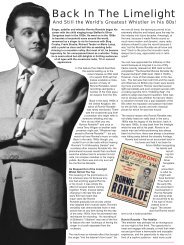the magazine for independent music makers - The Music Maker Guide
the magazine for independent music makers - The Music Maker Guide
the magazine for independent music makers - The Music Maker Guide
Create successful ePaper yourself
Turn your PDF publications into a flip-book with our unique Google optimized e-Paper software.
Electric Guitar Pickups<br />
<strong>The</strong> job of a pickup is to convert<br />
<strong>the</strong> vibration of a string into an<br />
electrical signal. <strong>The</strong> basic<br />
design consisting of a magnet and<br />
coil arrangement where <strong>the</strong> strings<br />
interact with <strong>the</strong> magnetic field to<br />
induce a voltage in <strong>the</strong> coil. Even<br />
with this simple concept, <strong>the</strong>re are<br />
quite a few variables and trade-offs.<br />
A common misunderstanding is that <strong>the</strong><br />
pickups on your guitar sound different<br />
because <strong>the</strong>y are made differently. Maybe<br />
<strong>the</strong>y are different, but <strong>the</strong>re is also a huge<br />
difference in sound caused by <strong>the</strong> pickup's<br />
position on <strong>the</strong> guitar.<br />
Most electric guitars up to around <strong>the</strong> 70's<br />
(including Fender and Gibson) generally<br />
used <strong>the</strong> same pickups in all positions, so it<br />
was <strong>the</strong> pickup's position alone that caused<br />
different sounds. <strong>The</strong>se days, it is more<br />
common to combine different pickup types,<br />
and use hotter pickups in <strong>the</strong> bridge position.<br />
Stronger magnets (or placing pickups closer<br />
to <strong>the</strong> strings) gives a higher output but also<br />
damps string vibration by pulling <strong>the</strong> strings<br />
towards <strong>the</strong> pickup. In severe cases, this can<br />
cause "false harmonics" or "double notes".<br />
Providing additional windings on <strong>the</strong> coil<br />
increases <strong>the</strong> output, particularly midrange.<br />
Manufacturers can only take this so far,<br />
because eventually <strong>the</strong> loss of highs gives a<br />
very muddy sound. Also <strong>the</strong> high output can<br />
overload <strong>the</strong> input of some preamps, making a<br />
"clean" sound impossible without reducing <strong>the</strong><br />
guitar volume setting (this may be desirable by<br />
some players). Additional coil windings produce<br />
a higher impedance which pose problems<br />
with treble loss when<br />
used with long cables.<br />
<strong>The</strong>re are similar options<br />
and compromises with<br />
coil wire gauge.<br />
"Active" pickups typically<br />
have a lower number of<br />
coil windings, giving a low<br />
output, low impedance,<br />
and very clean and clear,<br />
uncoloured sound. <strong>The</strong> low<br />
output is boosted by an onboard<br />
active preamp<br />
which maintains <strong>the</strong> low<br />
impedance. Low<br />
impedance pickups<br />
(on <strong>the</strong>ir own, or<br />
with a preamp)<br />
can drive long<br />
cables without<br />
noticeable treble<br />
loss.<br />
Probably <strong>the</strong><br />
most obvious<br />
difference in<br />
pickup<br />
designs is <strong>the</strong><br />
single pickup<br />
versus humbuckingpickup.<br />
A humbuckingpickup<br />
contains<br />
two single coils<br />
placed side by<br />
side, with a common<br />
magnet<br />
24<br />
arrangement. <strong>The</strong> sound is typically "fatter"<br />
(more midrange) due partly to <strong>the</strong> larger number<br />
of coil windings and partly because <strong>the</strong><br />
sound of <strong>the</strong> string is "read" over a longer portion<br />
of <strong>the</strong> string.<br />
<strong>The</strong> shape of <strong>the</strong> magnetic field af fects how<br />
much of <strong>the</strong> string is read. <strong>The</strong> pole-pieces<br />
you see on strat single coil pickup s are individual<br />
magnets and give a very focused magnetic<br />
field, reading a<br />
small section of<br />
<strong>the</strong> string vibration.<br />
On <strong>the</strong><br />
o<strong>the</strong>r hand,<br />
screws in a humbucking<br />
pickup are just<br />
screws, but conduct <strong>the</strong> magnetic<br />
field from a magnet placed<br />
underneath <strong>the</strong> pickup. <strong>The</strong>re is ano<strong>the</strong>r set of<br />
magnetically conductive slugs in <strong>the</strong> o<strong>the</strong>r coil,<br />
so <strong>the</strong> combined humbucker reads a larger<br />
length of string vibration.<br />
Magnetic material also affects tone. Popular<br />
opinion is that Alnico II produces a sweet, vintage<br />
sound, while Alnico V is a little stronger,<br />
and gives a brighter, more attacking tone (ideal<br />
<strong>for</strong> rock). Ceramic magnets have a slightly<br />
harder edge, and are favoured by met al players.<br />
With so many variables it's easy to see why<br />
<strong>the</strong>re are many different choices. <strong>The</strong>re are a<br />
few established standards, notably <strong>the</strong> original<br />
Fender Stratocaster, Gibson PAF, along with<br />
some popular models from retrofit manufacturers<br />
like DiMarzio, EMG and Seymour Duncan.<br />
Even be<strong>for</strong>e you plug your guitar in, its character<br />
is determined greatly by <strong>the</strong> type of guit ar<br />
woods used, construction methods, string<br />
gauges, etc. It is this basic character that <strong>the</strong><br />
pickup picks up, adding its own colouration.<br />
O<strong>the</strong>r Pickup Types<br />
All of <strong>the</strong> above desribe magnetic pickup s<br />
which are by far <strong>the</strong> most common pickup s<br />
used on electric guitars. <strong>The</strong>y are designed to<br />
work with strings that interact with a magnetic<br />
field, so <strong>the</strong>y are not normally subject to<br />
acoustic feedback (you can't talk into one!).<br />
<strong>The</strong>se magnetic pickups CAN be microphonic if<br />
anything metallic in or around <strong>the</strong>m is loose<br />
and vibrates with <strong>the</strong> sound. This is common in<br />
old and cheap pickups that have loose coil<br />
windings or fittings. It is rarely a problem with<br />
modern pickups that are wax potted to make<br />
sure everything is secure.<br />
Magnetic pickups are not suitable <strong>for</strong> nylon<br />
acoustic guitars, because nylon strings connot<br />
interact with a magnetic field. Even <strong>for</strong> steelstring<br />
acoustic guitars, magnetic pickups are<br />
raraely favoured, because of <strong>the</strong>ir limited frequency<br />
range, and <strong>the</strong> fact that <strong>the</strong>y read only<br />
a small portion of <strong>the</strong> string length. For<br />
acoustic guitars, it is essential to capture <strong>the</strong><br />
vibration of <strong>the</strong> top, and this is most commonly<br />
done with a piezo pickup mounted underneath<br />
Piezo<br />
<strong>the</strong> bridge saddle.<br />
Piezo pickups use crytals to detect pressure<br />
changes, and provide a very wide frequency<br />
response. <strong>The</strong>y also have a very high impedance<br />
(typically over 5 Meg), and <strong>the</strong>re<strong>for</strong>e need<br />
to be buffered with a preamp. This is usually<br />
provided in <strong>the</strong> acoustic guitar itself, often with<br />
extra tone control options, such as bass, middle<br />
and treble.<br />
Opinions vary, but <strong>the</strong>se piezo pickups convey<br />
about half of <strong>the</strong> sound of an acoustic guit ar.<br />
Acoustic guitars are just about always recorded<br />
with one or more very high quality microphones,<br />
but this is difficult to do effectifely in a<br />
live environment.<br />
Many guitar <strong>makers</strong>, such as Parker (with <strong>the</strong>ir<br />
revolutionary Fly series), Godin, and o<strong>the</strong>rs<br />
have added piezo bridges to solid body electric<br />
guitars. <strong>The</strong>se guitars offer standard electric<br />
sounds, acoustic sounds, and even <strong>the</strong> ability<br />
to mix both! <strong>The</strong>ir acoustic sounds can be quite<br />
convincing in a band setting, mainly because of<br />
<strong>the</strong> wide frequency response, and partly by <strong>the</strong><br />
conditioning we listeners have had from piezo<br />
equipped acoustic guitars.<br />
Fishman, L R Baggs and o<strong>the</strong>r manufacturers<br />
offer bridge piezo pickups that can be added to<br />
many guitars.<br />
Fishman offer an<br />
interesting pickup<br />
<strong>for</strong> acoustic guitars<br />
presently,<br />
called <strong>the</strong> Rare<br />
Earth pickup. It<br />
is a slim magnetic<br />
pickup that<br />
clamps<br />
into <strong>the</strong><br />
soundhole<br />
Apparently,<br />
<strong>the</strong> rare earth<br />
magnetic material<br />
provides a wider frequency<br />
response than typical<br />
electric guitar magnets. Also, a<br />
"deluxe" model includes a microphone<br />
that you can<br />
bend underneath<br />
inside <strong>the</strong> guitar, providing<br />
you with a<br />
blended acoustic and magnetic sound.<br />
MUSIC<br />
MAKER





